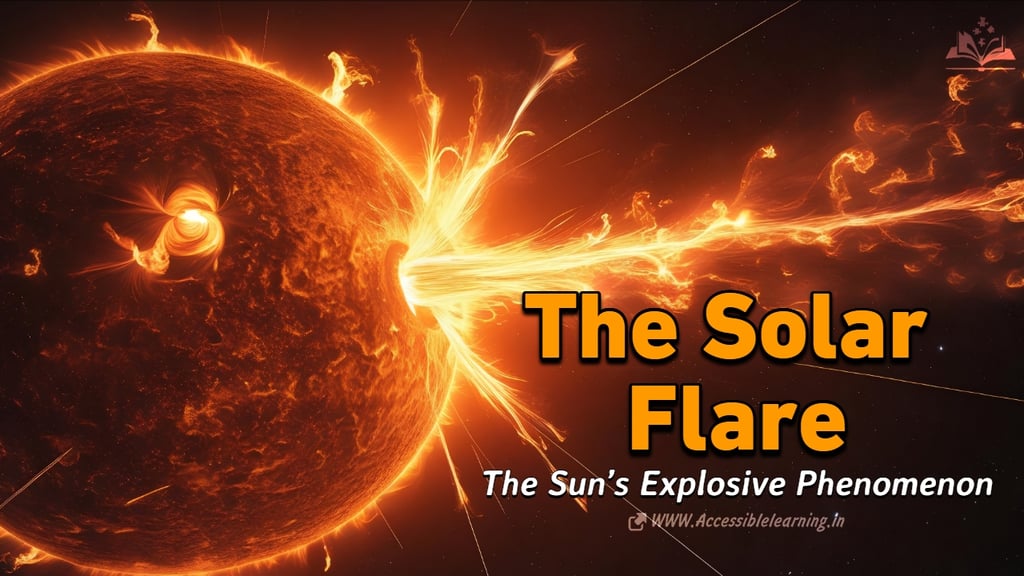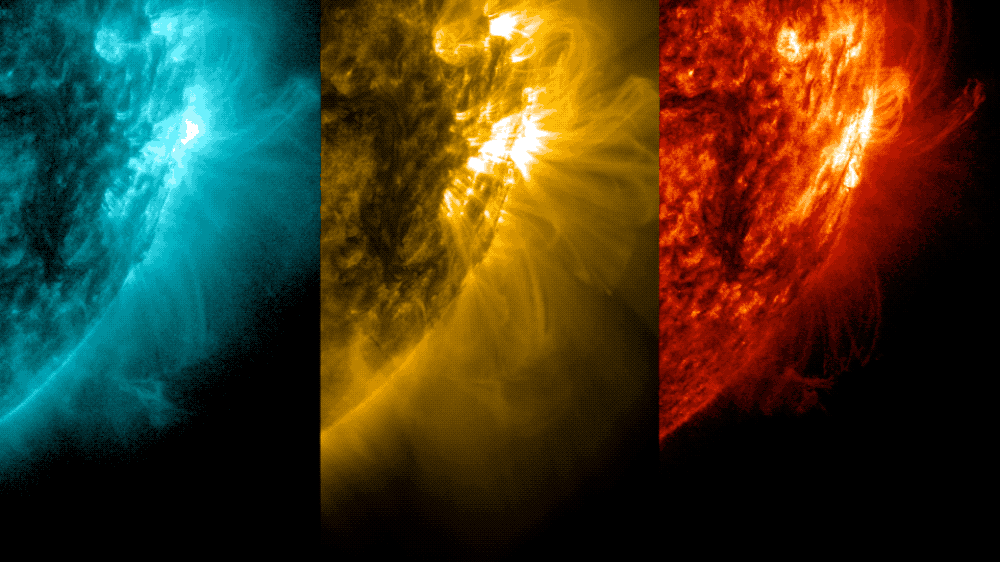
Solar Flares: Causes, Effects, and Scientific Discoveries
Explore the fascinating world of solar flares—what they are, how they form, their classifications, and their effects on Earth’s technology and space weather. Learn about historical solar storms, future research, and prediction methods.
ENVIRONMENTGLOBAL ISSUESAWARE/VIGILANTISRO/NASA
Kim Shin
2/11/20255 min read


The Sun, our life-giving star, is a dynamic and ever-changing celestial body. Among its many fascinating phenomena, solar flares stand out as some of the most powerful and dramatic events in our solar system. These sudden bursts of energy, radiation, and charged particles can have far-reaching effects on Earth and space weather. But what exactly are solar flares? How do they form? And what implications do they have for our planet? This article explores the science behind solar flares, their causes, classifications, and their potential impact on human technology and life.
What is a Solar Flare?
A solar flare is an intense burst of electromagnetic radiation and energy released from the Sun's surface due to magnetic activity. These eruptions occur when magnetic fields near sunspots become twisted and suddenly release their stored energy, causing a massive explosion of light, heat, and particles into space.
Solar flares are often associated with coronal mass ejections (CMEs)—large expulsions of plasma and magnetic field from the Sun's corona. However, not all solar flares result in CMEs, and not all CMEs are accompanied by flares.
How Do Solar Flares Form?
The Sun’s surface is highly active, with complex magnetic field lines constantly shifting and tangling due to the Sun’s rotation and convection currents. When these magnetic field lines suddenly snap and realign, a vast amount of energy is released in the form of a solar flare. This process is known as magnetic reconnection.
The energy from a solar flare is emitted across the entire electromagnetic spectrum, from radio waves to X-rays and gamma rays. The intensity of the flare depends on how much energy is released during the magnetic reconnection.
Classification of Solar Flares
Solar flares are classified based on their X-ray brightness in the 1-8 Ångström wavelength range, as measured by NASA's Geostationary Operational Environmental Satellites (GOES). The classification system includes
A-Class Flares (Weakest)
Almost negligible impact on Earth.
B-Class Flares
Slightly stronger than A-class but still insignificant in terms of space weather effects.
C-Class Flares (Moderate)
Can cause minor disturbances to Earth's ionosphere but generally do not affect technology.
M-Class Flares (Strong)
Can cause radio blackouts in the polar regions and minor disruptions to satellites and power grids.
X-Class Flares (Most Powerful)
Can trigger widespread radio blackouts, satellite damage, and even geomagnetic storms that impact power grids and GPS systems on Earth
Each class is further divided into a logarithmic scale (e.g., X1, X2, X3, etc.), where each increase represents a tenfold rise in energy output.
Impact of Solar Flares on Earth
While solar flares occur nearly every day, only the most powerful ones can significantly impact Earth. Some of the key effects include:
Disruptions to Communications and GPS
Solar flares release bursts of X-rays and extreme ultraviolet (EUV) radiation, which ionize the Earth’s upper atmosphere, causing disruptions in radio signals and GPS navigation systems.
Power Grid Failures
Large solar flares, especially those associated with CMEs, can induce geomagnetic storms, which in turn generate electrical currents in power grids. This can lead to blackouts, as seen during the 1989 Quebec blackout, which left millions without power.
Increased Radiation Hazards for Astronauts and Airlines
The high-energy particles from solar flares pose a threat to astronauts aboard the International Space Station (ISS) and can also increase radiation exposure for airline passengers flying over polar regions.
Auroras (Northern and Southern Lights)
On the brighter side, solar flares and CMEs can create spectacular auroras, also known as the Northern Lights (Aurora Borealis) and Southern Lights (Aurora Australis), due to the interaction of charged particles with Earth's magnetic field.


Notable Solar Flares in History
Some of the most significant solar flares recorded include:
The Carrington Event (1859)
The most powerful geomagnetic storm ever recorded.
Telegraph systems worldwide failed, and auroras were seen as far south as the Caribbean.
The Solar Storm of 1989
A powerful X-class flare led to the Quebec power grid failure, leaving 6 million people in Canada without electricity.
The Halloween Storms (2003)
One of the most intense solar activity periods in modern times, disrupting satellites and causing power grid fluctuations.
The Bastille Day Event (2000)
A major solar storm that led to satellite malfunctions and increased radiation exposure for astronauts.
Can We Predict Solar Flares?
Scientists use a combination of space telescopes, solar observatories, and advanced models to predict solar flare activity. NASA and NOAA monitor the Sun through:
Solar and Heliospheric Observatory (SOHO)
Solar Dynamics Observatory (SDO)
Parker Solar Probe
GOES Satellites
While prediction methods have improved, accurately forecasting the timing and intensity of solar flares remains a challenge due to the complexity of the Sun’s magnetic activity.
The Future of Solar Flare Research
The study of solar flares is becoming increasingly important as our dependence on technology grows. Scientists are working on improving space weather forecasting, developing better shielding technologies for spacecraft and power grids, and increasing international cooperation to mitigate the effects of powerful solar storms.
NASA’s Parker Solar Probe, launched in 2018, is making groundbreaking observations by venturing closer to the Sun than ever before, helping researchers understand the mechanisms behind solar flares and space weather.


Frequently Asked Questions (FAQs)
What is a solar flare?
A solar flare is a sudden and intense burst of energy, light, and radiation released from the Sun due to magnetic activity. It occurs when twisted magnetic fields near sunspots reconnect, releasing stored energy.
How are solar flares classified?
A-Class: Weakest, negligible impact.
B-Class: Slightly stronger but still insignificant.
C-Class: Moderate, minor disturbances to Earth’s ionosphere.
M-Class: Strong, causes radio blackouts and minor satellite disruptions.
X-Class: Most powerful; can cause geomagnetic storms, power grid failures, and major technological disruptions.
Can solar flares harm humans on Earth?
No, Earth’s atmosphere shields us from harmful solar radiation. However, powerful solar flares can disrupt satellites, GPS, radio communications, and power grids.
Do solar flares cause auroras?
Yes, solar flares, especially those associated with coronal mass ejections (CMEs), send charged particles toward Earth, interacting with our magnetic field and creating beautiful auroras.
Can solar flares be predicted?
While solar flare monitoring has improved, exact predictions remain difficult. Space agencies like NASA and NOAA use satellites such as SOHO, SDO, and the Parker Solar Probe to study solar activity.
What was the most powerful solar flare ever recorded?
The Carrington Event of 1859 was the most powerful geomagnetic storm, causing global telegraph system failures and auroras visible as far south as the Caribbean.
How do solar flares affect astronauts and space missions?
Solar flares emit harmful radiation that can pose serious risks to astronauts in space. Space agencies provide radiation shielding and safety protocols to minimize exposure.
How often do solar flares occur?
Small solar flares happen daily, but powerful ones are less frequent and tend to occur more during the peak of the 11-year solar cycle.
Can solar flares cause internet or mobile network failures?
Yes, strong solar flares can interfere with radio signals, satellite communications, and undersea internet cables, leading to temporary network disruptions.
Are solar flares related to climate change?
No, solar flares temporarily affect Earth’s upper atmosphere but do not contribute to long-term climate change.


Solar flares are a testament to the Sun’s immense power, capable of both dazzling light shows in the sky and serious technological disruptions on Earth. As our dependence on technology grows, understanding and predicting solar flares becomes increasingly important. Continued research and space monitoring are crucial to mitigating risks and ensuring we are prepared for future solar storms. With missions like the Parker Solar Probe and advancements in space weather forecasting, humanity is steadily unlocking the secrets of these fiery solar eruptions.
As we continue exploring the cosmos, the study of solar flares reminds us of the delicate balance between our planet and the ever-changing Sun.
Subscribe to our newsletter
All © Copyright reserved by Accessible-Learning
| Terms & Conditions
Knowledge is power. Learn with Us. 📚


